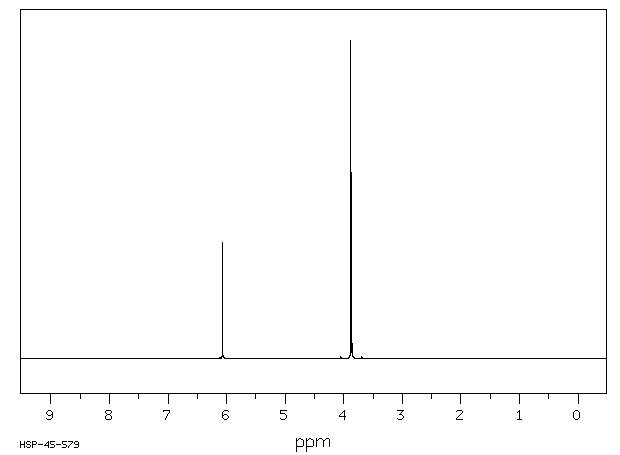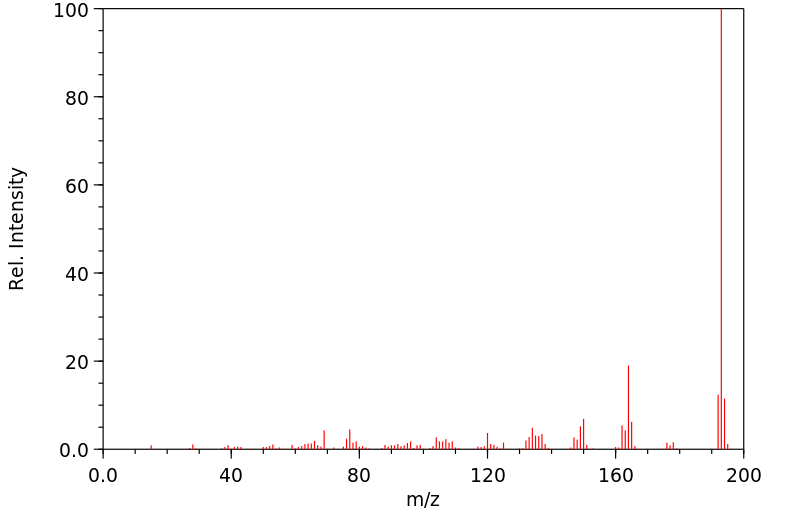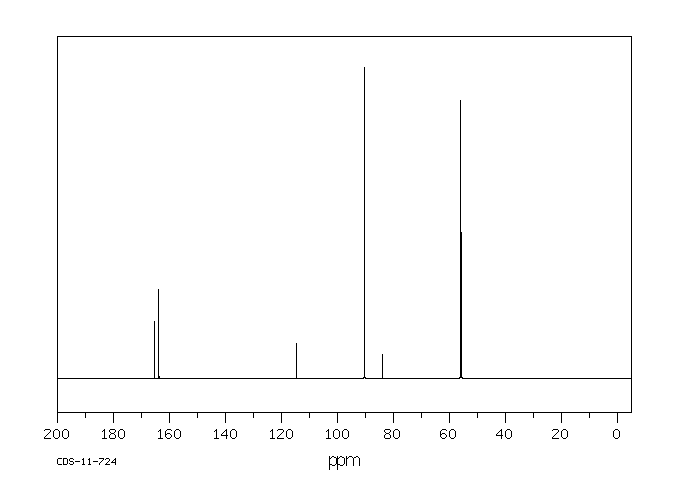2,4,6-三甲氧基苯甲腈 | 2571-54-2
中文名称
2,4,6-三甲氧基苯甲腈
中文别名
2,4,6-三甲氧苯腈;2,4,6-三甲氧基苯腈;2,4,6-三甲氧基苄氰
英文名称
2,4,6-trimethoxybenzonitrile
英文别名
——
CAS
2571-54-2
化学式
C10H11NO3
mdl
——
分子量
193.202
InChiKey
GBRHJUMDNWLSCT-UHFFFAOYSA-N
BEILSTEIN
——
EINECS
——
-
物化性质
-
计算性质
-
ADMET
-
安全信息
-
SDS
-
制备方法与用途
-
上下游信息
-
文献信息
-
表征谱图
-
同类化合物
-
相关功能分类
-
相关结构分类
物化性质
-
熔点:143-145 °C(lit.)
-
沸点:329.41°C (rough estimate)
-
密度:1.2307 (rough estimate)
-
稳定性/保质期:
如果按照规格使用和储存,则不会分解,也未有已知危险发生。
计算性质
-
辛醇/水分配系数(LogP):1.6
-
重原子数:14
-
可旋转键数:3
-
环数:1.0
-
sp3杂化的碳原子比例:0.3
-
拓扑面积:51.5
-
氢给体数:0
-
氢受体数:4
安全信息
-
危险等级:6.1
-
危险品标志:T
-
安全说明:S26,S37/39,S45
-
危险类别码:R23/24/25
-
WGK Germany:3
-
海关编码:2926909090
-
包装等级:III
-
危险类别:6.1
-
危险品运输编号:3276
-
储存条件:请将药品存放在密闭、阴凉干燥的地方保存。
SDS
| Name: | 2 4 6-Trimethoxybenzonitrile 98% Material Safety Data Sheet |
| Synonym: | None |
| CAS: | 2571-54-2 |
Synonym:None
Section 2 - COMPOSITION, INFORMATION ON INGREDIENTS
| CAS# | Chemical Name | content | EINECS# |
| 2571-54-2 | 2,4,6-Trimethoxybenzonitrile | 98 | 219-917-4 |
Risk Phrases: 23/24/25
Section 3 - HAZARDS IDENTIFICATION
EMERGENCY OVERVIEW
Toxic by inhalation, in contact with skin and if swallowed.The toxicological properties of this material have not been fully investigated.
Potential Health Effects
Eye:
May cause eye irritation.
Skin:
May cause skin irritation.
Ingestion:
May cause irritation of the digestive tract. The toxicological properties of this substance have not been fully investigated.
Metabolism may release cyanide, which may result in headache, dizziness, weakness, collapse, unconsciousness and possible death.
Inhalation:
May cause respiratory tract irritation. The toxicological properties of this substance have not been fully investigated. May be metabolized to cyanide which in turns act by inhibiting cytochrome oxidase impairing cellular respiration.
Chronic:
No information found.
Section 4 - FIRST AID MEASURES
Eyes: Flush eyes with plenty of water for at least 15 minutes, occasionally lifting the upper and lower eyelids. Get medical aid.
Skin:
Get medical aid. Flush skin with plenty of water for at least 15 minutes while removing contaminated clothing and shoes. Wash clothing before reuse.
Ingestion:
Get medical aid. Do NOT induce vomiting. If conscious and alert, rinse mouth and drink 2-4 cupfuls of milk or water.
Inhalation:
Remove from exposure and move to fresh air immediately. If not breathing, give artificial respiration. If breathing is difficult, give oxygen. Get medical aid. Do NOT use mouth-to-mouth resuscitation. If breathing has ceased apply artificial respiration using oxygen and a suitable mechanical device such as a bag and a mask.
Notes to Physician:
Section 5 - FIRE FIGHTING MEASURES
General Information:
As in any fire, wear a self-contained breathing apparatus in pressure-demand, MSHA/NIOSH (approved or equivalent), and full protective gear. During a fire, irritating and highly toxic gases may be generated by thermal decomposition or combustion.
Extinguishing Media:
Use agent most appropriate to extinguish fire. Use water spray, dry chemical, carbon dioxide, or appropriate foam.
Section 6 - ACCIDENTAL RELEASE MEASURES
General Information: Use proper personal protective equipment as indicated in Section 8.
Spills/Leaks:
Vacuum or sweep up material and place into a suitable disposal container. Clean up spills immediately, observing precautions in the Protective Equipment section. Avoid generating dusty conditions.
Provide ventilation.
Section 7 - HANDLING and STORAGE
Handling:
Wash thoroughly after handling. Use with adequate ventilation.
Minimize dust generation and accumulation. Avoid contact with eyes, skin, and clothing. Keep container tightly closed. Avoid ingestion and inhalation.
Storage:
Store in a tightly closed container. Store in a cool, dry, well-ventilated area away from incompatible substances.
Section 8 - EXPOSURE CONTROLS, PERSONAL PROTECTION
Engineering Controls:
Facilities storing or utilizing this material should be equipped with an eyewash facility and a safety shower. Use adequate ventilation to keep airborne concentrations low.
Exposure Limits CAS# 2571-54-2: Personal Protective Equipment Eyes: Wear appropriate protective eyeglasses or chemical safety goggles as described by OSHA's eye and face protection regulations in 29 CFR 1910.133 or European Standard EN166.
Skin:
Wear appropriate protective gloves to prevent skin exposure.
Clothing:
Wear appropriate protective clothing to prevent skin exposure.
Respirators:
A respiratory protection program that meets OSHA's 29 CFR 1910.134 and ANSI Z88.2 requirements or European Standard EN 149 must be followed whenever workplace conditions warrant respirator use.
Section 9 - PHYSICAL AND CHEMICAL PROPERTIES
Physical State: Powder
Color: white
Odor: Not available.
pH: Not available.
Vapor Pressure: Not available.
Viscosity: Not available.
Boiling Point: Not available.
Freezing/Melting Point: 139.00 - 141.00 deg C
Autoignition Temperature: Not applicable.
Flash Point: Not applicable.
Explosion Limits, lower: Not available.
Explosion Limits, upper: Not available.
Decomposition Temperature:
Solubility in water:
Specific Gravity/Density:
Molecular Formula: C10H11NO3
Molecular Weight: 193.20
Section 10 - STABILITY AND REACTIVITY
Chemical Stability:
Stable at room temperature in closed containers under normal storage and handling conditions.
Conditions to Avoid:
Incompatible materials, dust generation, excess heat.
Incompatibilities with Other Materials:
Oxidizing agents.
Hazardous Decomposition Products:
Carbon monoxide, oxides of nitrogen, irritating and toxic fumes and gases, carbon dioxide.
Hazardous Polymerization: Has not been reported
Section 11 - TOXICOLOGICAL INFORMATION
RTECS#:
CAS# 2571-54-2 unlisted.
LD50/LC50:
Not available.
Carcinogenicity:
2,4,6-Trimethoxybenzonitrile - Not listed by ACGIH, IARC, or NTP.
Section 12 - ECOLOGICAL INFORMATION
Section 13 - DISPOSAL CONSIDERATIONS
Dispose of in a manner consistent with federal, state, and local regulations.
Section 14 - TRANSPORT INFORMATION
IATA
Shipping Name: TOXIC SOLID, ORGANIC, N.O.S.*
Hazard Class: 6.1
UN Number: 2811
Packing Group: III
IMO
Shipping Name: TOXIC SOLID, ORGANIC, N.O.S.
Hazard Class: 6.1
UN Number: 2811
Packing Group: III
RID/ADR
Shipping Name: TOXIC SOLID, ORGANIC, N.O.S.
Hazard Class: 6.1
UN Number: 2811
Packing group: III
Section 15 - REGULATORY INFORMATION
European/International Regulations
European Labeling in Accordance with EC Directives
Hazard Symbols: T
Risk Phrases:
R 23/24/25 Toxic by inhalation, in contact with skin
and if swallowed.
Safety Phrases:
S 28A After contact with skin, wash immediately with
plenty of water.
S 37 Wear suitable gloves.
S 45 In case of accident or if you feel unwell, seek
medical advice immediately (show the label where
possible).
WGK (Water Danger/Protection)
CAS# 2571-54-2: No information available.
Canada
None of the chemicals in this product are listed on the DSL/NDSL list.
CAS# 2571-54-2 is not listed on Canada's Ingredient Disclosure List.
US FEDERAL
TSCA
CAS# 2571-54-2 is not listed on the TSCA inventory.
It is for research and development use only.
SECTION 16 - ADDITIONAL INFORMATION
N/A
上下游信息
-
上游原料
中文名称 英文名称 CAS号 化学式 分子量 2,4-二甲氧基苯甲腈 2,4-dimethoxybenzonitrile 4107-65-7 C9H9NO2 163.176 2,4,6-三甲氧基甲苯 2,4,6-trimethoxytoluene 14107-97-2 C10H14O3 182.219 2,4,6-三甲氧基苯甲醛 2,4,6-Trimethoxybenzaldehyde 830-79-5 C10H12O4 196.203 —— 2,4,6-trimethoxybenzaldehyde oxime 51903-38-9 C10H13NO4 211.218 4-甲氧基苯甲腈 4-methoxybenzonitrile 874-90-8 C8H7NO 133.15 -
下游产品
中文名称 英文名称 CAS号 化学式 分子量 —— 2,4,6-trimethoxybenzonitrile N-oxide 2904-59-8 C10H11NO4 209.202 2,4,6-三甲氧基苄胺 2,4,6-trimethoxybenzylamine 77648-20-5 C10H15NO3 197.234
反应信息
-
作为反应物:描述:参考文献:名称:Weygand,F. et al., Chemische Berichte, 1968, vol. 101, # 10, p. 3623 - 3641摘要:DOI:
-
作为产物:描述:2,4,6-三甲氧基苯甲醛 在 XY-zeolite 、 盐酸羟胺 作用下, 反应 0.02h, 以90%的产率得到2,4,6-三甲氧基苯甲腈参考文献:名称:使用 HY 沸石将醛非常方便和高效地一锅法转化为腈类和酮类转化为酰胺摘要:使用 HY-沸石作为催化剂,醛类转化为腈类和酮类转化为酰胺类可以方便有效地进行一锅法转化。已经研究了微波辐射和常规方法。DOI:10.1055/s-2002-22701
文献信息
-
Condensed-Phase, Halogen-Bonded CF<sub>3</sub>I and C<sub>2</sub>F<sub>5</sub>I Adducts for Perfluoroalkylation Reactions作者:Filippo Sladojevich、Eric McNeill、Jonas Börgel、Shao-Liang Zheng、Tobias RitterDOI:10.1002/anie.201410954日期:2015.3.16family of practical, liquid trifluoromethylation and pentafluoroethylation reagents is described. We show how halogen bonding can be used to obtain easily handled liquid reagents from gaseous CF3I and CF3CF2I. The synthetic utility of the new reagents is exemplified by a novel direct arene trifluoromethylation reaction as well as adaptations of other perfluoroalkylation reactions.
-
Practical one-pot conversion of aryl bromides and β-bromostyrenes into aromatic nitriles and cinnamonitriles作者:Genki Ishii、Ryo Harigae、Katsuhiko Moriyama、Hideo TogoDOI:10.1016/j.tet.2012.12.022日期:2013.2reactions are practical and environmentally benign one-pot methods for the preparation of aromatic nitriles, cinnamonitriles, and aliphatic nitriles from aryl bromides, β-bromostyrenes, and alkyl bromides, respectively, through the formation of Grignard reagents and their DMF or N-formylpiperidine adducts.通过用Mg车削和随后的DMF处理,然后用分子碘和NH 3水溶液处理,各种芳基溴化物以良好的产率有效地转化为相应的芳族腈。相同的处理芳基溴化物,其是弱反应到Mg屑,与我PrMgCl·LiCl并随后DMF,接着用分子碘治疗和水溶液NH 3也得到相应的芳香腈以良好的收率。另一方面,当使用N-甲酰基哌啶代替DMF时,对位取代的β-溴苯乙烯被转化为相应的对位取代的肉桂腈,即α,β-不饱和腈,通过相同的方法具有良好至中等的收率。该反应通过简单的实验程序进行,不需要任何有毒的金属氰化物或昂贵的稀有金属。因此,本反应是实用的,对环境有益的一锅法,可通过形成格氏试剂及其DMF或DMF分别由芳基溴化物,β-溴苯乙烯和烷基溴化物制备芳族腈,肉桂腈和脂族腈。N-甲酰基哌啶加合物。
-
Copper-Mediated Cyanation of Aryl Halides by Activation of Benzyl Cyanide as the Cyanide Source作者:Qiaodong Wen、Jisong Jin、Yuncai Mei、Ping Lu、Yanguang WangDOI:10.1002/ejoc.201300052日期:2013.7Aryl nitriles were efficiently synthesized through copper-mediated cyanation of aryl halides using benzyl cyanide as the cyanide source. Aryl halides with various substituents on the aromatic ring afforded the corresponding aryl nitriles in 32–97 % yields (25 examples). This reaction could also be carried on a gram scale by using commercially available reagents. Additionally, a C–H bond oxidation and
-
Copper- and Silver-Mediated Cyanation of Aryl Iodides Using DDQ as Cyanide Source作者:Kui Zheng、Peng Yu、Shuyou Chen、Fen Chen、Jiang ChengDOI:10.1002/cjoc.201201140日期:2013.4A new copper and silver‐mediated cyanation of aryl iodides with DDQ as a cyanide source is achieved, providing nitriles with good yields. This new approach represents a safe method leading to aryl nitriles.
-
Copper-Catalyzed One-Pot Synthesis of Quinazolinones from 2-Nitrobenzaldehydes with Aldehydes: Application toward the Synthesis of Natural Products作者:Subrata Sahoo、Shantanu PalDOI:10.1021/acs.joc.1c02343日期:2021.12.17A novel, efficient, and atom-economical approach for the construction of quinazolinones from 2-nitrobenzaldehydes has been unveiled via copper-catalyzed nitrile formation, hydrolysis, and reduction in one pot for the first time. In this reaction, urea is used as a source of nitrogen for nitrile formation, hydrazine hydrate is used for both the reduction of the nitro group and the hydrolysis of nitrile
表征谱图
-
氢谱1HNMR
-
质谱MS
-
碳谱13CNMR
-
红外IR
-
拉曼Raman
-
峰位数据
-
峰位匹配
-
表征信息
同类化合物
(βS)-β-氨基-4-(4-羟基苯氧基)-3,5-二碘苯甲丙醇
(S,S)-邻甲苯基-DIPAMP
(S)-(-)-7'-〔4(S)-(苄基)恶唑-2-基]-7-二(3,5-二-叔丁基苯基)膦基-2,2',3,3'-四氢-1,1-螺二氢茚
(S)-盐酸沙丁胺醇
(S)-3-(叔丁基)-4-(2,6-二甲氧基苯基)-2,3-二氢苯并[d][1,3]氧磷杂环戊二烯
(S)-2,2'-双[双(3,5-三氟甲基苯基)膦基]-4,4',6,6'-四甲氧基联苯
(S)-1-[3,5-双(三氟甲基)苯基]-3-[1-(二甲基氨基)-3-甲基丁烷-2-基]硫脲
(R)富马酸托特罗定
(R)-(-)-盐酸尼古地平
(R)-(-)-4,12-双(二苯基膦基)[2.2]对环芳烷(1,5环辛二烯)铑(I)四氟硼酸盐
(R)-(+)-7-双(3,5-二叔丁基苯基)膦基7''-[((6-甲基吡啶-2-基甲基)氨基]-2,2'',3,3''-四氢-1,1''-螺双茚满
(R)-(+)-7-双(3,5-二叔丁基苯基)膦基7''-[(4-叔丁基吡啶-2-基甲基)氨基]-2,2'',3,3''-四氢-1,1''-螺双茚满
(R)-(+)-7-双(3,5-二叔丁基苯基)膦基7''-[(3-甲基吡啶-2-基甲基)氨基]-2,2'',3,3''-四氢-1,1''-螺双茚满
(R)-(+)-4,7-双(3,5-二-叔丁基苯基)膦基-7“-[(吡啶-2-基甲基)氨基]-2,2”,3,3'-四氢1,1'-螺二茚满
(R)-3-(叔丁基)-4-(2,6-二苯氧基苯基)-2,3-二氢苯并[d][1,3]氧杂磷杂环戊烯
(R)-2-[((二苯基膦基)甲基]吡咯烷
(R)-1-[3,5-双(三氟甲基)苯基]-3-[1-(二甲基氨基)-3-甲基丁烷-2-基]硫脲
(N-(4-甲氧基苯基)-N-甲基-3-(1-哌啶基)丙-2-烯酰胺)
(5-溴-2-羟基苯基)-4-氯苯甲酮
(5-溴-2-氯苯基)(4-羟基苯基)甲酮
(5-氧代-3-苯基-2,5-二氢-1,2,3,4-oxatriazol-3-鎓)
(4S,5R)-4-甲基-5-苯基-1,2,3-氧代噻唑烷-2,2-二氧化物-3-羧酸叔丁酯
(4S,4''S)-2,2''-亚环戊基双[4,5-二氢-4-(苯甲基)恶唑]
(4-溴苯基)-[2-氟-4-[6-[甲基(丙-2-烯基)氨基]己氧基]苯基]甲酮
(4-丁氧基苯甲基)三苯基溴化磷
(3aR,8aR)-(-)-4,4,8,8-四(3,5-二甲基苯基)四氢-2,2-二甲基-6-苯基-1,3-二氧戊环[4,5-e]二恶唑磷
(3aR,6aS)-5-氧代六氢环戊基[c]吡咯-2(1H)-羧酸酯
(2Z)-3-[[(4-氯苯基)氨基]-2-氰基丙烯酸乙酯
(2S,3S,5S)-5-(叔丁氧基甲酰氨基)-2-(N-5-噻唑基-甲氧羰基)氨基-1,6-二苯基-3-羟基己烷
(2S,2''S,3S,3''S)-3,3''-二叔丁基-4,4''-双(2,6-二甲氧基苯基)-2,2'',3,3''-四氢-2,2''-联苯并[d][1,3]氧杂磷杂戊环
(2S)-(-)-2-{[[[[3,5-双(氟代甲基)苯基]氨基]硫代甲基]氨基}-N-(二苯基甲基)-N,3,3-三甲基丁酰胺
(2S)-2-[[[[[((1S,2S)-2-氨基环己基]氨基]硫代甲基]氨基]-N-(二苯甲基)-N,3,3-三甲基丁酰胺
(2S)-2-[[[[[[((1R,2R)-2-氨基环己基]氨基]硫代甲基]氨基]-N-(二苯甲基)-N,3,3-三甲基丁酰胺
(2-硝基苯基)磷酸三酰胺
(2,6-二氯苯基)乙酰氯
(2,3-二甲氧基-5-甲基苯基)硼酸
(1S,2S,3S,5S)-5-叠氮基-3-(苯基甲氧基)-2-[(苯基甲氧基)甲基]环戊醇
(1S,2S,3R,5R)-2-(苄氧基)甲基-6-氧杂双环[3.1.0]己-3-醇
(1-(4-氟苯基)环丙基)甲胺盐酸盐
(1-(3-溴苯基)环丁基)甲胺盐酸盐
(1-(2-氯苯基)环丁基)甲胺盐酸盐
(1-(2-氟苯基)环丙基)甲胺盐酸盐
(1-(2,6-二氟苯基)环丙基)甲胺盐酸盐
(-)-去甲基西布曲明
龙蒿油
龙胆酸钠
龙胆酸叔丁酯
龙胆酸
龙胆紫-d6
龙胆紫










